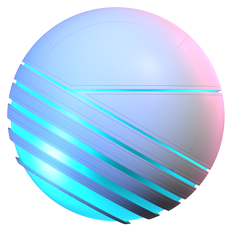Leaderboard
Popular Content
Showing content with the highest reputation on 06/15/2022 in all areas
-
Based on the time stamps of both messages, you realize that Cerbera cooked up that design in 9 minutes....and all quads. Just another example of stream of consciousness modeling: the phenomenon where you are so in-tune with the application that you really are not aware of the steps you are taking; they just occur out of muscle memory. Similar to how a good typist is not even aware of the keyboard as the novel is being written, that is how Cerbera works with C4D's modeling tools. He just wills the polygons into existence and the object is formed. I would imagine that there are days after he has modeled the complexities of a 9-iron for a client where he wonders to himself "Hmmm....got that done quicker than I thought. OMG! Its 6 PM already!!!! Where did the day go! I completely missed lunch" ...yes...I am jealous. 😀 Dave2 points
-
Hi y'all, I registered a while back but now I paid the dollas I better start introducing! 😁 I'm a graphic designer and self-taught digital artist from Amsterdam, working almost exclusively in the dance music industry. I've been using Cinema 4D for 10 years now but I still feel like a rookie sometimes being totally perplexed about why it ain't working. So I'm very much looking forward stepping up my game here and hopefully fix some of them mysteries with you!1 point
-
I didn't know that, thank you so much! I will try that 🙂 @kbarI actually purchased your plugin it's great! I didn't know it had s26 support, I will have to install it until maxon supports it directly. Thank you!1 point
-
No, not at all. The first example was from @eikonoklastes- which had ngons. I'm learning Houdini so took that and reworked it a different way - just for the exercise. My version was quad based. It was just a different approach. I thought I'd better get it done in quads, because I thought you'd be along shortly 🤣 PS: @Igorand @eikonoklasteshave been great support in getting my Houdini journey started,1 point
-
The short answer is that this is one of those very rare shapes that Extrude alone cannot deal with ! The reasons for that are to do with the way it averages / combines contributing edges' angles of conjunction at points of termination and the extrapolation thereof, in which there is scope for error, and the way that error manifests is the inaccurate positioning of the newly extruded surface. Simple hey ? No, but I am less interested in the 'why does it do that ?' than in the 'how do we get around it ?' once we accept it does, as we surely must...🙂 I started off by removing the ngons in the base shape caused by that rogue vertex in the middle on one side. Then we have the option to Inset all faces, but we shouldn't do that. Instead we will apply a bevel in Solid mode so that we get box corners everywhere, which are the best chance of controlling and defining the geometry there particularly in relation to keeping corners sharp after any future subdivision. But it also has a corollary effect of allowing Extrude to better know what is going on and thereby allow it to work in a (slightly) more easily correctable way. Now, some things to note. If Extrude fails, so will a Zero-extrude and subsequent Normal Move; they both use the same 'averaging' calculations to get the result, so the same errors will occur. So instead we have to do the extrude, and fix its fail points manually, which isn't ideal, but is what we have to do ! I would be interested to see if the extrude functions in Blender and Houdini can do better. So we need X-ray mode at this point, so we can see exactly what is occurring throughout our extrude process, and thereby see what we need to correct to make up for its shortcomings. And in most cases we will have just a single vertex to move at each of the major points of the model. Initially we should do that by eye, but when you are close you can break out such new tools as Straighten Edges (or HB_lineUp if you have HB Modelling bundle) to further repair things. This one took me about 5 mins to clean up to a standard I would call 'reasonable' ! If there is a way to do all this automatically I have not yet found it, and suspect I never will, unless scene nodes can come dramatically to the rescue, but alas I don't have the time today to get into those... UPDATE: Fellow C4D alumni Noseman has since pointed out that we can see the erroneous extrude directions if we look at the Vertex normals (with the phong tag set at a similarly high angle to that we needed to use in the Extrude)... As those are not directly editable, that would seem to be the end of that particular avenue, at least as far as auto-type solutions are concerned... CBR1 point
-
I'm not a modeling expert, so I should probably keep my mouth shut. But I'd like to learn, too, so I just give it a shot as long as nobody more knowledgable has replied. From your screenshots, I'm a bit confused and the project file doesn't seem to contain the cut version. Maybe I'm going in the wrong direction... a) Your backside screenshot looks as if you'd want to adjust the Maximum Angle for Preserve Groups before extruding. b) Then I'd do a extrude with zero offset and afterwards use the Normal Move tool. As I said, if the result is bogus, just ignore my post and wait for some of the pros...1 point
-
Ugh never again ! This bloody thing took a month, on and off a few hours here and there before work and single handedly changed my out look on life XD. it’s based on a Tie Interceptor, most of the greebles are my custom design an interceptor 2.0 if you will and was over all a massive pain in the rear end 😄 it was more a test of modelling prowess for me anyway 🙂1 point
-
Thanks! But unfortunately no, did not work. Just realized, I can delete the xRef object in the OM. But in the xRef manager I can't remove anything... Edit: just restored the backup file from this morning.1 point
-
There is an refresh issue. Additionally in the classic import node you have to change to local or global transforms. If you then move the null and press "A" on your keyboard it will force viewport refresh. If you animate the null it will work (with Time dependent enabled in classic op node)1 point
-
Very nicely done. Your setup is leagues simpler than mine. Really like the way you're already exploiting Group Expression. Having said that, you don't get precise control over the number of points in the circles that I do, so I'm calling this one a draw! Regarding the corner sharpness, the Subdivide SOP can read weight attributes on points, vertices and prims. For points, you use cornerweight (this is detailed in the docs). I've attached a scene that also uses another trick to grab only the corner points by measuring their curvature. Circle Holes without Booleans_MA04.hiplc1 point
-
Splines in extrudes if you want to do it fast. But if you want to do it nicely then starting with a 64 segment disc primitive (with inner radius) for the main circle would be a good start. Other than that it's all very simple primitive shapes you just need to get the segmentation right so you can connect things like the reference. Then add thickness as needed via regular extrude. If you want to use SDS you'd need some control loops as well obviously, and quads are good, but ultimately not necessary, as no part of this isn't planar. CBR1 point
-
Sorry, Im not sure I can see where anyone suggested rendering at double the frame rate? Outside of the framerate mismatches, what you're trying to show on screen just fundamentally will not work on a low framerate project. You're moving a large, crisp, detailed object across the screen at too high of a speed. This means the model is jumping ~100 pixels per frame. This happens in 3d and real world camera footage, it isnt limited to 3d rendering. Ways to fix this: 1) Use a higher framerate project, and by this, I mean higher for everything including the final delivered product. You can't just render it high, then chop it back down to 24fps again. If the object moves 100 pixels per frame on a 24fps project, then it would only move ~35 pixels per frame in a 60fps project. But of course all your rendering and editing gets slower because now you have more frames 2) Use motion blur. I can see your renders do have motion blur, but the settings arent high enough for the movement. On this project you need a 180 degree shutter, or about 0.02 seconds (1 second, divided by 24fps, divided by 2 (for the 180 degree shutter angle)) of blur per frame in order for it to look natural. Less than this and it will flicker, higher than this and it will smudge. 3) Slow down the camera movement. Lower movement = less stuttering 4) Change the camera movement. Your zooms are fine, because even though the camera may move quickly, visually everything just gets a few pixels larger or smaller. Same for rotations, theyre fine because the object isnt moving across the screen. Only pans and tracks will strobe like this. Someone had a similar problem a while back, maybe this helps demonstrate the issue more. Unfortunately their links now problem, but it had the same strobing as they panned the camera left to right1 point
-
The best greebling starts with looking at industrial designs in today's world. Look at the structure of oil tanks, the supports for large hangers, how piping flows in oil refineries. Probably the reason why kit-bashing works in sci-fi model building is because they are using real world shapes from model kits based on real world objects. Thus, when you see this collection of details, your mind accepts that visual language because it is based in a world you unconsciously understand. As an example, consider one of the most famous sci-fi models in the world today: You see these shapes, accept them as real but you don't immediately go "hey -- those are engine components!". So start with basic hull plating techniques but break up that area of paneling with objects modelled from real world industrial components. Also, remember that negative space (no detail at all) also works to add visual interest because it helps direct the eye. Sometimes procedural greebling across every surface creates just too much visual information and can be tiring to look at --- and thus subconsciously read as completely fake. It really is an art and has its own "form language" that actually requires a bit of study to fully understand. I am sure there are rules behind that language. Hopefully that video Iceman posted talks about some of those rules. Dave1 point






